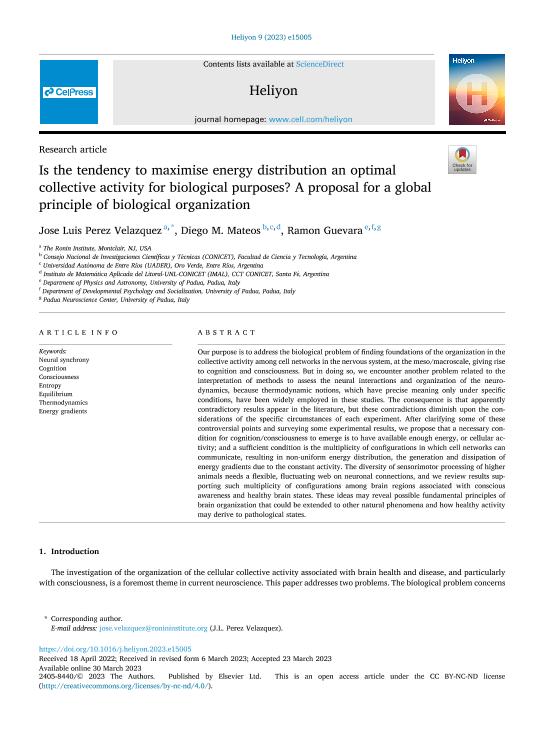Mostrar el registro sencillo del ítem
dc.contributor.author
Perez Velazquez, Jose Luis
dc.contributor.author
Mateos, Diego Martín

dc.contributor.author
Guevara, Ramon
dc.date.available
2023-12-12T14:40:25Z
dc.date.issued
2023-04
dc.identifier.citation
Perez Velazquez, Jose Luis; Mateos, Diego Martín; Guevara, Ramon; Is the tendency to maximise energy distribution an optimal collective activity for biological purposes? A proposal for a global principle of biological organization; Elsevier; Heliyon; 9; 4; 4-2023; 1-19
dc.identifier.issn
2405-8440
dc.identifier.uri
http://hdl.handle.net/11336/220016
dc.description.abstract
Our purpose is to address the biological problem of finding foundations of the organization in the collective activity among cell networks in the nervous system, at the meso/macroscale, giving rise to cognition and consciousness. But in doing so, we encounter another problem related to the interpretation of methods to assess the neural interactions and organization of the neurodynamics, because thermodynamic notions, which have precise meaning only under specific conditions, have been widely employed in these studies. The consequence is that apparently contradictory results appear in the literature, but these contradictions diminish upon the considerations of the specific circumstances of each experiment. After clarifying some of these controversial points and surveying some experimental results, we propose that a necessary condition for cognition/consciousness to emerge is to have available enough energy, or cellular activity; and a sufficient condition is the multiplicity of configurations in which cell networks can communicate, resulting in non-uniform energy distribution, the generation and dissipation of energy gradients due to the constant activity. The diversity of sensorimotor processing of higher animals needs a flexible, fluctuating web on neuronal connections, and we review results supporting such multiplicity of configurations among brain regions associated with conscious awareness and healthy brain states. These ideas may reveal possible fundamental principles of brain organization that could be extended to other natural phenomena and how healthy activity may derive to pathological states.
dc.format
application/pdf
dc.language.iso
eng
dc.publisher
Elsevier

dc.rights
info:eu-repo/semantics/openAccess
dc.rights.uri
https://creativecommons.org/licenses/by-nc-nd/2.5/ar/
dc.subject
COGNITION
dc.subject
CONSCIOUSNESS
dc.subject
ENERGY GRADIENTS
dc.subject
ENTROPY
dc.subject
EQUILIBRIUM
dc.subject
NEURAL SYNCHRONY
dc.subject
THERMODYNAMICS
dc.subject.classification
Astronomía

dc.subject.classification
Ciencias Físicas

dc.subject.classification
CIENCIAS NATURALES Y EXACTAS

dc.title
Is the tendency to maximise energy distribution an optimal collective activity for biological purposes? A proposal for a global principle of biological organization
dc.type
info:eu-repo/semantics/article
dc.type
info:ar-repo/semantics/artículo
dc.type
info:eu-repo/semantics/publishedVersion
dc.date.updated
2023-12-12T13:09:11Z
dc.journal.volume
9
dc.journal.number
4
dc.journal.pagination
1-19
dc.journal.pais
Países Bajos

dc.journal.ciudad
Amsterdam
dc.description.fil
Fil: Perez Velazquez, Jose Luis. The Ronin Institute; Estados Unidos
dc.description.fil
Fil: Mateos, Diego Martín. Consejo Nacional de Investigaciones Científicas y Técnicas. Centro Científico Tecnológico Conicet - Santa Fe. Instituto de Matemática Aplicada del Litoral. Universidad Nacional del Litoral. Instituto de Matemática Aplicada del Litoral; Argentina. Universidad Autónoma de Entre Ríos; Argentina
dc.description.fil
Fil: Guevara, Ramon. Università di Padova; Italia
dc.journal.title
Heliyon
dc.relation.alternativeid
info:eu-repo/semantics/altIdentifier/doi/http://dx.doi.org/10.1016/j.heliyon.2023.e15005
dc.relation.alternativeid
info:eu-repo/semantics/altIdentifier/url/https://www.sciencedirect.com/science/article/pii/S2405844023022120
Archivos asociados
